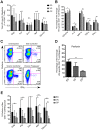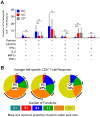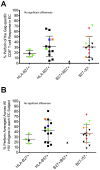Perforin expression directly ex vivo by HIV-specific CD8 T-cells is a correlate of HIV elite control
- PMID: 20523897
- PMCID: PMC2877741
- DOI: 10.1371/journal.ppat.1000917
Perforin expression directly ex vivo by HIV-specific CD8 T-cells is a correlate of HIV elite control
Abstract
Many immune correlates of CD8(+) T-cell-mediated control of HIV replication, including polyfunctionality, proliferative ability, and inhibitory receptor expression, have been discovered. However, no functional correlates using ex vivo cells have been identified with the known ability to cause the direct elimination of HIV-infected cells. We have recently discovered the ability of human CD8(+) T-cells to rapidly upregulate perforin--an essential molecule for cell-mediated cytotoxicity--following antigen-specific stimulation. Here, we examined perforin expression capability in a large cross-sectional cohort of chronically HIV-infected individuals with varying levels of viral load: elite controllers (n = 35), viremic controllers (n = 29), chronic progressors (n = 27), and viremic nonprogressors (n = 6). Using polychromatic flow cytometry and standard intracellular cytokine staining assays, we measured perforin upregulation, cytokine production, and degranulation following stimulation with overlapping peptide pools encompassing all proteins of HIV. We observed that HIV-specific CD8(+) T-cells from elite controllers consistently display an enhanced ability to express perforin directly ex vivo compared to all other groups. This ability is not restricted to protective HLA-B haplotypes, does not require proliferation or the addition of exogenous factors, is not restored by HAART, and primarily originates from effector CD8(+) T-cells with otherwise limited functional capability. Notably, we found an inverse relationship between HIV-specific perforin expression and viral load. Thus, the capability of HIV-specific CD8(+) T-cells to rapidly express perforin defines a novel correlate of control in HIV infection.
Conflict of interest statement
The authors have declared that no competing interests exist.
Figures





Similar articles
-
CD8+ T Cell Breadth and Ex Vivo Virus Inhibition Capacity Distinguish between Viremic Controllers with and without Protective HLA Class I Alleles.J Virol. 2016 Jul 11;90(15):6818-6831. doi: 10.1128/JVI.00276-16. Print 2016 Aug 1. J Virol. 2016. PMID: 27194762 Free PMC article.
-
Increased HIV-specific CD8+ T-cell cytotoxic potential in HIV elite controllers is associated with T-bet expression.Blood. 2011 Apr 7;117(14):3799-808. doi: 10.1182/blood-2010-12-322727. Epub 2011 Feb 2. Blood. 2011. PMID: 21289310 Free PMC article.
-
Differential expression of perforin in cytotoxic lymphocyte in HIV/AIDS patients of China.J Clin Immunol. 2006 Jul;26(4):339-46. doi: 10.1007/s10875-006-9027-1. Epub 2006 Jun 13. J Clin Immunol. 2006. PMID: 16770700
-
CD8+ T-cells: function and response to HIV infection.Curr HIV Res. 2004 Jan;2(1):23-37. doi: 10.2174/1570162043485077. Curr HIV Res. 2004. PMID: 15053338 Review.
-
Immune Responses in Controllers of HIV Infection.Annu Rev Immunol. 2024 Jun;42(1):21-33. doi: 10.1146/annurev-immunol-083122-035233. Epub 2024 Jun 14. Annu Rev Immunol. 2024. PMID: 37827174 Review.
Cited by
-
Gut germinal center regeneration and enhanced antiviral immunity by mesenchymal stem/stromal cells in SIV infection.JCI Insight. 2021 Jun 22;6(12):e149033. doi: 10.1172/jci.insight.149033. JCI Insight. 2021. PMID: 34014838 Free PMC article.
-
CAR Talk: How Cancer-Specific CAR T Cells Can Instruct How to Build CAR T Cells to Cure HIV.Front Immunol. 2019 Sep 27;10:2310. doi: 10.3389/fimmu.2019.02310. eCollection 2019. Front Immunol. 2019. PMID: 31611880 Free PMC article. Review.
-
Activation associated ERK1/2 signaling impairments in CD8+ T cells co-localize with blunted polyclonal and HIV-1 specific effector functions in early untreated HIV-1 infection.PLoS One. 2013 Oct 15;8(10):e77412. doi: 10.1371/journal.pone.0077412. eCollection 2013. PLoS One. 2013. PMID: 24143233 Free PMC article.
-
A real-time killing assay to follow viral epitope presentation to CD8 T cells.J Immunol Methods. 2013 Dec 15;398-399:60-7. doi: 10.1016/j.jim.2013.09.009. Epub 2013 Sep 20. J Immunol Methods. 2013. PMID: 24060536 Free PMC article. Clinical Trial.
-
MicroRNA-directed program of cytotoxic CD8+ T-cell differentiation.Proc Natl Acad Sci U S A. 2013 Nov 12;110(46):18608-13. doi: 10.1073/pnas.1317191110. Epub 2013 Oct 25. Proc Natl Acad Sci U S A. 2013. PMID: 24163352 Free PMC article.
References
-
- Lambotte O, Boufassa F, Madec Y, Nguyen A, Goujard C, et al. HIV controllers: a homogeneous group of HIV-1-infected patients with spontaneous control of viral replication. Clin Infect Dis. 2005;41:1053–1056. - PubMed
-
- Lefrere JJ, Mariotti M, Morand-Joubert L, Thauvin M, Roudot-Thoraval F. Plasma human immunodeficiency virus RNA below 40 Copies/mL is rare in untreated persons even in the first years of infection. J Infect Dis. 1999;180:526–529. - PubMed
-
- Deeks SG, Walker BD. Human immunodeficiency virus controllers: mechanisms of durable virus control in the absence of antiretroviral therapy. Immunity. 2007;27:406–416. - PubMed
-
- Frahm N, Kiepiela P, Adams S, Linde CH, Hewitt HS, et al. Control of human immunodeficiency virus replication by cytotoxic T lymphocytes targeting subdominant epitopes. Nat Immunol. 2006;7:173–178. - PubMed
Publication types
MeSH terms
Substances
Grants and funding
LinkOut - more resources
Full Text Sources
Other Literature Sources
Medical
Research Materials

